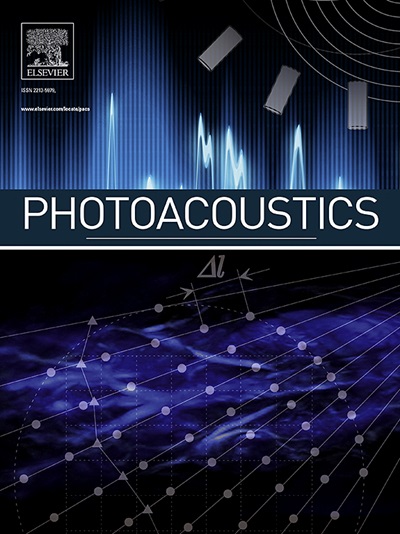High spectral energy density all-fiber nanosecond pulsed 1.7 μm light source for photoacoustic microscopy
IF 7.1
1区 医学
Q1 ENGINEERING, BIOMEDICAL
引用次数: 0
Abstract
We present a high spectral energy density all-fiber nanosecond pulsed 1.7 μm light source specifically designed for photoacoustic microscopy (PAM). The system targets the 1st overtone absorption of C–H bonds near 1720 nm within the near-infrared-III (NIR-III) window, where lipids exhibit strong optical absorption, and tissues benefit from reduced scattering and high permissible fluence. To achieve narrow-linewidth, high pulse energy, and high pulse repetition rate (PRR), we developed a master oscillator fiber amplifier architecture based on stimulated Raman scattering. A 1589.80 nm Raman pump and a custom-built narrow-linewidth Raman seed laser were employed to generate spectrally pure 1719.44 nm pulses (∼0.10 nm linewidth). The proposed light source delivers nanosecond pulses (∼5 ns) with high pulse energy (≥2.2 μJ) and tunable PRRs up to 300 kHz, resulting in a spectral energy density of approximately 22 μJ/nm—significantly higher than that of conventional 1.7 μm light sources. Performance of the NIR-PAM system was validated through resolution testing with a 1951 USAF target, demonstrating a spatial resolution of approximately 4.14 μm and an axial resolution of approximately 85.5 μm. Phantom imaging of CH2-rich polymer films and ex vivo lipid-rich biological tissues confirmed the system’s high spatial fidelity and strong contrast for lipid-specific structures. This compact, stable, and spectrally refined light source with high spectral energy density can offer an effective solution for high-resolution, label-free molecular imaging and represents a promising platform for clinical photoacoustic imaging applications involving lipid detection and metabolic disease diagnostics.
用于光声显微镜的高光谱能量密度全光纤纳秒脉冲1.7 μm光源
提出了一种高光谱能量密度的全光纤纳秒脉冲1.7 μm光声显微镜光源。该系统的目标是在近红外- iii (NIR-III)窗口内1720 nm附近的C-H键的一阶泛音吸收,脂类具有强的光学吸收,组织受益于减少的散射和高允许的通量。为了实现窄线宽、高脉冲能量和高脉冲重复率(PRR),我们开发了一种基于受激拉曼散射的主振荡器光纤放大器结构。采用1589.80 nm的拉曼泵和定制的窄线宽拉曼种子激光器产生光谱纯1719.44 nm的脉冲(线宽~ 0.10 nm)。该光源提供纳秒脉冲(~ 5 ns),脉冲能量高(≥2.2 μJ), PRRs可调至300 kHz,光谱能量密度约为22 μJ/nm,显著高于传统的1.7 μm光源。通过1951年美国空军目标的分辨率测试验证了NIR-PAM系统的性能,其空间分辨率约为4.14 μm,轴向分辨率约为85.5 μm。富ch2聚合物薄膜和离体富脂生物组织的幻影成像证实了该系统的高空间保真度和对脂质特异性结构的强烈对比。这种紧凑、稳定、光谱精细的光源具有高光谱能量密度,可以为高分辨率、无标记的分子成像提供有效的解决方案,并代表了一个有前途的临床光声成像应用平台,包括脂质检测和代谢疾病诊断。
本文章由计算机程序翻译,如有差异,请以英文原文为准。
求助全文
约1分钟内获得全文
求助全文
来源期刊

Photoacoustics
Physics and Astronomy-Atomic and Molecular Physics, and Optics
CiteScore
11.40
自引率
16.50%
发文量
96
审稿时长
53 days
期刊介绍:
The open access Photoacoustics journal (PACS) aims to publish original research and review contributions in the field of photoacoustics-optoacoustics-thermoacoustics. This field utilizes acoustical and ultrasonic phenomena excited by electromagnetic radiation for the detection, visualization, and characterization of various materials and biological tissues, including living organisms.
Recent advancements in laser technologies, ultrasound detection approaches, inverse theory, and fast reconstruction algorithms have greatly supported the rapid progress in this field. The unique contrast provided by molecular absorption in photoacoustic-optoacoustic-thermoacoustic methods has allowed for addressing unmet biological and medical needs such as pre-clinical research, clinical imaging of vasculature, tissue and disease physiology, drug efficacy, surgery guidance, and therapy monitoring.
Applications of this field encompass a wide range of medical imaging and sensing applications, including cancer, vascular diseases, brain neurophysiology, ophthalmology, and diabetes. Moreover, photoacoustics-optoacoustics-thermoacoustics is a multidisciplinary field, with contributions from chemistry and nanotechnology, where novel materials such as biodegradable nanoparticles, organic dyes, targeted agents, theranostic probes, and genetically expressed markers are being actively developed.
These advanced materials have significantly improved the signal-to-noise ratio and tissue contrast in photoacoustic methods.
 求助内容:
求助内容: 应助结果提醒方式:
应助结果提醒方式:


